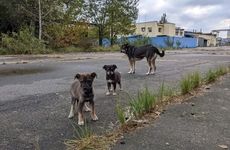
NEW YORK – Researchers at the US National Human Genome Research Institute and elsewhere have characterized the genetic structure of free-roaming dogs living at varying distances from the Chernobyl power plant exclusion zone almost 40 years after the 1986 nuclear disaster.
"To date, no population genetic studies of Chernobyl organisms have included large-bodied mammals, such as canines," the authors noted. "Thus, nonhuman mammals in the Chernobyl Exclusion Zone are greatly understudied, despite their potential to offer powerful insights into the history and survival of life in this hostile environment."
For the study, published in Science Advances on Friday, the researchers used Illumina canine SNP arrays to genotype blood samples of 302 dogs from three populations living at different distances from the disaster site: in and around the Chernobyl nuclear power plant, Chernobyl City, and Slavutych.
They found admixture between the three populations, especially those in geographically close areas, but also three discrete family groups within a small area. Overall, they defined 15 families of dogs.
The dogs showed low levels of heterozygosity, suggesting that they have been inbreeding. "We find that the dogs from the power plant are actually quite isolated," said lead author Gabriella Spatola, a graduate student at the University of South Carolina and NHGRI. "Our evidence shows that these dogs have been there since the time of the disaster and that they have been breeding together."
Next, the researchers compared the DNA of the Chernobyl dogs with that of over 160 purebred dogs and more than 10 global village dog populations from other parts of the world, including Eastern Europe. The results showed that the Chernobyl dogs shared ancestry with shepherd-related breeds and are genetically distinct from other village dogs.
While some of the findings suggest that the dogs in Chernobyl are descendants of pets that were left behind after the explosion, it is difficult to say this with certainty as some of the dog breeds owned before the nuclear accident may not have been represented in the purebred dataset, the researchers wrote.
The genetic structure of the Chernobyl dog population is the initial step toward studying the effects of continuous environmental radiation exposure on a large-bodied mammalian species. "We can now design the optimum experiments to identify positions in the genome which allowed dogs to live in high radiation areas compared to those breeding in low radiation areas," said corresponding author Elaine Ostrander, a geneticist at NHGRI. She added that she hopes future studies will help humans prepare better for nuclear disasters.
